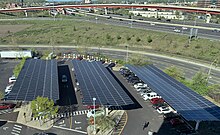|
Canopy (architecture)
  A canopy is a type of overhead roof or else a structure over which a fabric or metal covering is attached, able to provide shade or shelter from weather conditions such as sun, hail, snow and rain.[1] A canopy can also be a tent, generally without a floor. The word comes from the ancient Greek κωνώπειον (konópeion, "cover to keep insects off"), from κώνωψ (kónops, "cone-face"), which is a bahuvrihi compound meaning "mosquito". The first 'o' changing into 'a' may be due to influence from the place name Canopus, Egypt thought of as a place of luxuries. Architectural canopies include projections giving protection from the weather, or merely decoration.[2] Such canopies are supported by the building to which they are attached and often also by a ground mounting provided by not less than two stanchions, or upright support posts. Canopies can also stand alone, such as a fabric covered gazebo or cabana. Fabric canopies can meet various design needs. Many modern fabrics are long-lasting, bright, easily cleaned, strong and flame-retardant. This material can be vinyl, acrylic, polyester or canvas.[3] Modern frame materials offer high strength-to-weight ratios and corrosion resistance. The proper combination of these properties can result in safe, strong, economical and attractive products. Classification numbersConstruction Specifications Institute (CSI) Division 10 MasterFormat 2004 Edition:
CSI MasterFormat 1995 Edition:
Solar canopies Solar canopies are solar arrays installed on canopies, which could be a parking lot canopy, carport, gazebo, Pergola, or patio cover. See alsoReferences
External links
|